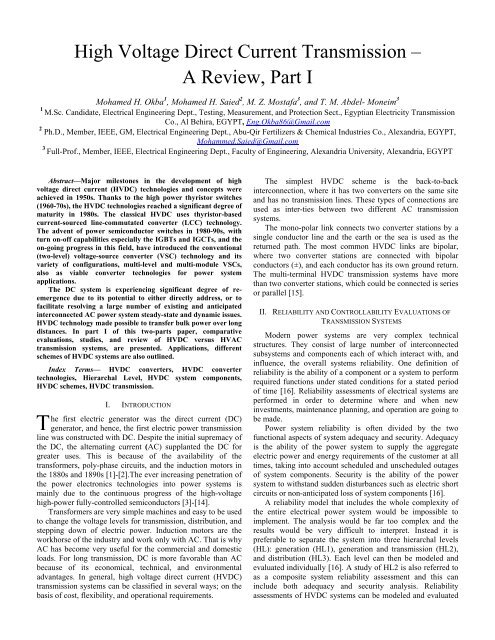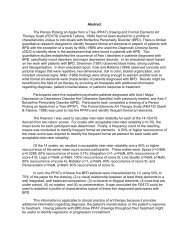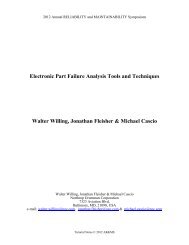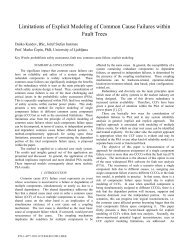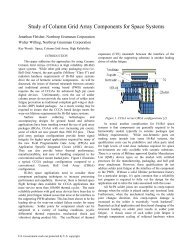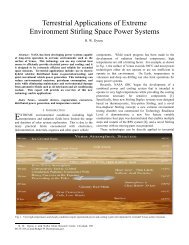High Voltage Direct Current Transmission – A Review, Part I
High Voltage Direct Current Transmission – A Review, Part I
High Voltage Direct Current Transmission – A Review, Part I
You also want an ePaper? Increase the reach of your titles
YUMPU automatically turns print PDFs into web optimized ePapers that Google loves.
<strong>High</strong> <strong>Voltage</strong> <strong>Direct</strong> <strong>Current</strong> <strong>Transmission</strong> <strong>–</strong><br />
A <strong>Review</strong>, <strong>Part</strong> I<br />
Mohamed H. Okba 1 , Mohamed H. Saied 2 , M. Z. Mostafa 3 , and T. M. Abdel- Moneim 3<br />
1 M.Sc. Candidate, Electrical Engineering Dept., Testing, Measurement, and Protection Sect., Egyptian Electricity <strong>Transmission</strong><br />
Co., Al Behira, EGYPT, Eng.Okba86@Gmail.com<br />
2 Ph.D., Member, IEEE, GM, Electrical Engineering Dept., Abu-Qir Fertilizers & Chemical Industries Co., Alexandria, EGYPT,<br />
Mohammed.Saied@Gmail.com<br />
3 Full-Prof., Member, IEEE, Electrical Engineering Dept., Faculty of Engineering, Alexandria University, Alexandria, EGYPT<br />
Abstract—Major milestones in the development of high<br />
voltage direct current (HVDC) technologies and concepts were<br />
achieved in 1950s. Thanks to the high power thyristor switches<br />
(1960-70s), the HVDC technologies reached a significant degree of<br />
maturity in 1980s. The classical HVDC uses thyristor-based<br />
current-sourced line-commutated converter (LCC) technology.<br />
The advent of power semiconductor switches in 1980-90s, with<br />
turn on-off capabilities especially the IGBTs and IGCTs, and the<br />
on-going progress in this field, have introduced the conventional<br />
(two-level) voltage-source converter (VSC) technology and its<br />
variety of configurations, multi-level and multi-module VSCs,<br />
also as viable converter technologies for power system<br />
applications.<br />
The DC system is experiencing significant degree of reemergence<br />
due to its potential to either directly address, or to<br />
facilitate resolving a large number of existing and anticipated<br />
interconnected AC power system steady-state and dynamic issues.<br />
HVDC technology made possible to transfer bulk power over long<br />
distances. In part I of this two-parts paper, comparative<br />
evaluations, studies, and review of HVDC versus HVAC<br />
transmission systems, are presented. Applications, different<br />
schemes of HVDC systems are also outlined.<br />
Index Terms— HVDC converters, HVDC converter<br />
technologies, Hierarchal Level, HVDC system components,<br />
HVDC schemes, HVDC transmission.<br />
T<br />
I. INTRODUCTION<br />
he first electric generator was the direct current (DC)<br />
generator, and hence, the first electric power transmission<br />
line was constructed with DC. Despite the initial supremacy of<br />
the DC, the alternating current (AC) supplanted the DC for<br />
greater uses. This is because of the availability of the<br />
transformers, poly-phase circuits, and the induction motors in<br />
the 1880s and 1890s [1]-[2].The ever increasing penetration of<br />
the power electronics technologies into power systems is<br />
mainly due to the continuous progress of the high-voltage<br />
high-power fully-controlled semiconductors [3]-[14].<br />
Transformers are very simple machines and easy to be used<br />
to change the voltage levels for transmission, distribution, and<br />
stepping down of electric power. Induction motors are the<br />
workhorse of the industry and work only with AC. That is why<br />
AC has become very useful for the commercial and domestic<br />
loads. For long transmission, DC is more favorable than AC<br />
because of its economical, technical, and environmental<br />
advantages. In general, high voltage direct current (HVDC)<br />
transmission systems can be classified in several ways; on the<br />
basis of cost, flexibility, and operational requirements.<br />
The simplest HVDC scheme is the back-to-back<br />
interconnection, where it has two converters on the same site<br />
and has no transmission lines. These types of connections are<br />
used as inter-ties between two different AC transmission<br />
systems.<br />
The mono-polar link connects two converter stations by a<br />
single conductor line and the earth or the sea is used as the<br />
returned path. The most common HVDC links are bipolar,<br />
where two converter stations are connected with bipolar<br />
conductors (±), and each conductor has its own ground return.<br />
The multi-terminal HVDC transmission systems have more<br />
than two converter stations, which could be connected is series<br />
or parallel [15].<br />
II. RELIABILITY AND CONTROLLABILITY EVALUATIONS OF<br />
TRANSMISSION SYSTEMS<br />
Modern power systems are very complex technical<br />
structures. They consist of large number of interconnected<br />
subsystems and components each of which interact with, and<br />
influence, the overall systems reliability. One definition of<br />
reliability is the ability of a component or a system to perform<br />
required functions under stated conditions for a stated period<br />
of time [16]. Reliability assessments of electrical systems are<br />
performed in order to determine where and when new<br />
investments, maintenance planning, and operation are going to<br />
be made.<br />
Power system reliability is often divided by the two<br />
functional aspects of system adequacy and security. Adequacy<br />
is the ability of the power system to supply the aggregate<br />
electric power and energy requirements of the customer at all<br />
times, taking into account scheduled and unscheduled outages<br />
of system components. Security is the ability of the power<br />
system to withstand sudden disturbances such as electric short<br />
circuits or non-anticipated loss of system components [16].<br />
A reliability model that includes the whole complexity of<br />
the entire electrical power system would be impossible to<br />
implement. The analysis would be far too complex and the<br />
results would be very difficult to interpret. Instead it is<br />
preferable to separate the system into three hierarchal levels<br />
(HL): generation (HL1), generation and transmission (HL2),<br />
and distribution (HL3). Each level can then be modeled and<br />
evaluated individually [16]. A study of HL2 is also referred to<br />
as a composite system reliability assessment and this can<br />
include both adequacy and security analysis. Reliability<br />
assessments of HVDC systems can be modeled and evaluated
separately and then included into HL2 to evaluate the effect of<br />
the overall system reliability. In reliability assessments of such<br />
HVDC systems, it is of great importance to know the<br />
technicalities of the system, in order to model it. The next<br />
section describes the HVDC systems details.<br />
The IEEE Standard is a guide for the evaluation of the<br />
HVDC converter stations reliability [17]. It promotes the basic<br />
concepts of reliability, availability, and maintainability (RAM)<br />
in all phases of the HVDC station’s life cycle. The intention of<br />
introducing these concepts of RAM in HVDC projects is to<br />
provide help in: i) Improving RAM for stations in service, ii)<br />
Calculating and comparing RAM for different HVDC designs,<br />
iii) Reducing costs, iv) Reducing spare parts, and v) Improving<br />
HVDC converter specifications [17]-[18]. In [19]-[28], several<br />
researches have been published covering the area of assessing<br />
the reliability of the HVDC system as a single system.<br />
On the other hand, the controllability of HVDC links offers<br />
firm transmission capacity without limitation due to network<br />
congestion or loop flow on parallel paths. Controllability<br />
allows the HVDC to ‘leap-frog’ multiple ‘choke-points’ or<br />
bypass sequential path limits in the AC network. Therefore, the<br />
utilization of HVDC links is usually higher than that for extra<br />
high voltage (EHV) AC transmission lowering the<br />
transmission cost per MWh. By eliminating loop flow,<br />
controllability frees up parallel transmission capacity for its<br />
intended purpose of serving intermediate load and providing<br />
an outlet for local generation [29].<br />
III. AC VERSUS DC TRANSMISSION<br />
As the rapid development of renewable energy generation,<br />
like wind and solar power generation, and high electrical<br />
power generated at long-distances, it is urgent to feed these<br />
distributed energy back to power grid through an economic<br />
and environmental way. Actually, AC is very familiar for<br />
industrial and domestic loads, but it has some limitations for<br />
long transmission lines. Moreover, as the city power load is<br />
increasing, the capacity of grid need to be expanded, despite<br />
that the overhead AC lines have already occupied much<br />
transmission space. In a word, a new transmission approach is<br />
needed to solve these and other problems, the DC<br />
transmission, which is being used in several projects [30],<br />
[31]-[32], and [33]-[34].<br />
Switching surges, for example, are the serious transient<br />
over voltages for the high voltage transmission lines. In case of<br />
AC transmission the peak values are 2 to 3 times normal crest<br />
voltage, where for DC transmission it is 1.7 times normal<br />
voltage. In addition to, the HVDC transmission has less corona<br />
and radio interferences than that of HVAC transmission line<br />
[35]-[37]. In the following section, comparisons of the HVDC<br />
with the conventional AC transmission systems are carried out.<br />
A. <strong>Transmission</strong> Costs Comparison<br />
The cost of any AC or DC transmission lines usually<br />
includes the cost of main components, such as; right-of-way<br />
(ROW), which is the amount of landscape that might be<br />
occupied during installations of towers, conductors, insulators,<br />
terminal equipment, in addition to the operational costs such as<br />
losses of transmission lines. For given operational constraints<br />
of both AC and DC lines, DC lines has the ability to carry as<br />
much power with two conductors as AC lines with three<br />
conductors of the same size. Moreover, DC lines require fewer<br />
infrastructures than AC lines, which will consequently reduce<br />
the cost of DC lines' installation.<br />
1) Economic Considerations:<br />
For a given transmission task, feasibility studies are carried<br />
out before the final decision of implementing of a HVAC or<br />
HVDC system. Whenever long distance transmission is<br />
discussed, the concept of “break-even distance” arises. This is<br />
where the savings in HVDC line costs offsets the higher<br />
converter station costs. Fig.1.a shows typical cost comparison<br />
curves between AC and DC transmissions, considering:<br />
Terminal station costs,<br />
Line costs, and<br />
Capitalized value of losses.<br />
The DC curve is not as steep as the AC curve because of<br />
considerably lower line costs per kilometer. For long AC lines,<br />
the cost of intermediate reactive power compensation has to be<br />
taken into account. The break-even distance is in the range of<br />
500 to 800 km depending on a number of other factors, like<br />
country-specific cost elements, interest rates for project<br />
financing, loss evaluation, cost of right-of-way, etc. [38]-[42].<br />
Fig. 1.b shows the power capacity versus distances for both<br />
AC and DC systems.<br />
1) Environmental Issues:<br />
A HVDC transmission system is basically environmentfriendly,<br />
because the improved energy transmission<br />
possibilities contribute to a more efficient utilization of<br />
existing power plants. The land coverage and the associated<br />
right-of-way cost for a HVDC overhead transmission line is<br />
not as high as that of an AC line [40]-[41]. This reduces the<br />
visual impact and saves land compensation for new projects. It<br />
is also possible to increase the power transmission capacity for<br />
existing rights of way.<br />
(a)<br />
(b)<br />
Fig. 1. Comparison between AC and DC systems, (a) Cost comparison curves,<br />
(b) Power capacity versus distances.
Tower structures of DC and AC overhead transmission<br />
lines are shown in Fig. 2.There are some environmental issues<br />
must be considered for the converter stations. These issues are<br />
focused in [43]-[45]. The use of ground or sea return paths in<br />
monopolar operation, electromagnetic compatibility, visual<br />
impact, and audible noise are explained in [46]-[48]. In [49],<br />
an overview of the engineering methods, tools, and design<br />
solutions is introduced. Verification methods used in HVDC<br />
converter stations design considering acoustic requirements are<br />
also explained.<br />
IV. VOLTAGE STABILITY OF HVDC VERSUS HVAC<br />
INTERCONNECTIONS<br />
Long transmission lines are required to deliver the power to<br />
the major load centers or the nearest connection point of the<br />
existing transmission network. For long transmission of bulk<br />
power several technical and economic issues have to be<br />
considered before an optimal decision can be made. <strong>Voltage</strong><br />
stability in general is one of the main technical issues to be<br />
considered [50]-[51]. Several methods, used to obtain the<br />
stability margin of a HVDC system, are well presented in the<br />
literature [51]-[59]. The most common voltage stability indices<br />
used for HVDC systems are maximum available power<br />
(MAP), critical effective short circuit ratio (CESCR) and<br />
voltage stability factor (VSF).<br />
The maximum power method, which determines MAP and<br />
the voltage sensitivity method to determine VSF are best<br />
described in [52]. These two methods coincide, i.e. the MAP<br />
point is reached when VSF nears infinite, if the converters are<br />
operated in constant extinction angle and constant power<br />
control mode. The basic P-V stability equations are also<br />
derived taking into account load characteristics and system<br />
parameters. These methods are applied in [53] to determine the<br />
most unfavorable load characteristics with respect to degrading<br />
power/voltage stability margins. This is done by analyzing the<br />
impact of load characteristic on maximum power instability<br />
(dP/dI) and MAP of the HVDC system. The Short Circuit<br />
Ratio (SCR) or CESCR are also considered as stability factors<br />
for an HVDC system, but only appropriate to evaluate the<br />
impacts of AC system on the stability margin of HVDC [60].<br />
Authors in [59] introduced a new index (dQt/eig_min) for<br />
voltage stability analysis of AC/DC systems. This index is<br />
used to classify the system into soft and non-soft modal<br />
systems. The latter is defined as the system with constant<br />
dQt/eig_min for all the SCRs and vice versa for the former.<br />
This index also serves as a basis to decide the type of reactive<br />
power compensation and HVDC control strategy.<br />
Fig.2. Typical transmission line structures for approximately 1000 MW.<br />
While the above mentioned indices can be used to compare<br />
voltage stability margins between HVDC systems, they are not<br />
applicable for HVAC and HVDC comparison. In [56], authors<br />
extend the conventional point of collapse (PoC) method<br />
developed for AC systems to determination of saddle-node<br />
bifurcation in systems including HVDC links. In [57], a<br />
comparison of the performance of the PoC and continuation<br />
methods for large AC/DC systems is presented. The proposed<br />
continuation method is applied in the two free softwarepackages<br />
for stability studies; (UWPflow) and (PSAT) [61]-<br />
[63].<br />
A nonlinear programming approach for estimating the<br />
voltage stability in AC/DC systems based on the above<br />
mentioned algorithms is presented in [59] where PoCs are<br />
found by solving an optimization problem for several test<br />
systems. However, more in-depth analytical explanation is<br />
required, and control issues of HVDC systems need to be<br />
considered. Inappropriate control schemes of firing, extinction,<br />
and overlap angles results in commutation failure or<br />
singularity in the Jacobian matrix. Therefore, PoC based on<br />
this method is not reliable to be used in the comparison of<br />
voltage stability of HVDC and HVAC systems. The dVac/dq<br />
factor at a particular bus is a commonly used voltage stability<br />
index in both AC and DC systems [51], [54]-[55]. However, it<br />
has never been used for comparison purposes between HVAC<br />
and HVDC systems.<br />
V. ADVANTAGES AND DISADVANTAGES OF HVDC<br />
Although the rationale for selection of HVDC is often<br />
economic, there may be other reasons for its selection. In many<br />
cases more AC lines are needed to deliver the same power over<br />
the same distance due to system stability limitations.<br />
Furthermore, the long distance AC lines usually require<br />
intermediate switching stations and reactive power<br />
compensation. This can increase the substation costs for AC<br />
transmission to the point where it is comparable to that for<br />
HVDC transmission [29].<br />
HVDC may be the only feasible way to interconnect two<br />
asynchronous networks, reduce fault currents, utilize long<br />
cable circuits, bypass network congestion, share utility rightsof-way<br />
without degradation of reliability, and mitigate<br />
environmental concerns. In all of these applications, HVDC<br />
nicely complements the AC transmission system. The<br />
following points highlight different advantages and<br />
disadvantages of the HVDC systems [29].<br />
A. Advantages<br />
1) Greater power per conductor.<br />
2) Simpler line construction and smaller transmission<br />
towers.<br />
3) A bipolar HVDC line uses only two insulated sets of<br />
conductors, rather than three.<br />
4) Narrower right-of-way.<br />
5) Require only one-third the insulated sets of conductors as<br />
a double circuit AC line.<br />
6) Approximate savings of 30% in line construction.<br />
7) Ground return can be used.<br />
8) Each conductor can be operated as an independent<br />
circuit.<br />
9) No charging current at steady state.
10) No Skin effect.<br />
11) Lower line losses.<br />
12) Line power factor is always unity.<br />
13) Line does not require reactive compensation.<br />
14) Synchronous operation is not required.<br />
15) Distances are not limited by stability.<br />
16) May interconnect AC systems of different frequencies.<br />
17) Low short-circuit current on D.C line.<br />
18) Does not contribute to short-circuit current of an AC<br />
system.<br />
19) Controllability allows the HVDC to ‘leap-frog’ multiple<br />
‘choke-points’.<br />
20) No physical restriction limiting the distance or power<br />
level for HVDC underground or submarine cables<br />
21) Can be used on shared ROW with other utilities<br />
22) Considerable savings in installed cable and losses costs<br />
for underground or submarine cable systems [29].<br />
B. Disadvantages<br />
1) Converters are expensive.<br />
2) Converters require much reactive power.<br />
3) Multi-terminal or network operation is not easy.<br />
4) Converters generate harmonics and hence, require filters.<br />
5) Break-even distance is influenced by the costs of right-ofway<br />
and line construction with a typical value of 500 km<br />
[38]-[40].<br />
VI. APPLICATIONS OF HVDC TRANSMISSION SYSTEMS<br />
HVDC has gradually become a mature technology for AC<br />
system interconnection since the commissioning of the first<br />
commercial project between Mainland Sweden to Gotland<br />
island in 1954 [30]. The applications of HVDC technology are<br />
justified by some special conditions where HVDC is the most<br />
feasible or may be the only solution. Such applications include<br />
bulk power transmission over long distances, sub-marine cable<br />
transmission, and asynchronous systems inter-connection<br />
[64].HVDC transmission applications can be broken down to<br />
the following different basic categories [29], [37] AND [64].<br />
A. Long Distance Bulk Power <strong>Transmission</strong><br />
As shown above, HVDC transmission systems often<br />
provide a more economical alternative to AC transmission, for<br />
exploiting the high electrical power generated at long-distances<br />
and bulk-power delivery from clean remote resources, such as;<br />
hydroelectric developments, mine-mouth power plants, solar,<br />
large-scale wind farms, or major hot-rock geothermal energy.<br />
This transmission is established using fewer lines with HVDC<br />
than with AC transmission.<br />
B. Cable <strong>Transmission</strong><br />
Unlike the case for AC cables, there is no physical<br />
restriction limiting the distance or power level for HVDC<br />
underground or submarine cables. Underground cables can be<br />
used on shared ROW with other utilities, without impacting<br />
reliability concerns over use of common corridors. Saving<br />
advantages of underground and submarine cable systems ‘have<br />
been shown previously, knowing that depending on the power<br />
level to be transmitted; these savings can offset the higher<br />
converter station costs at distances of 40 km or more.<br />
On the other hand, for AC transmission over a distance,<br />
there is a drop-off in cable capacity due to its reactive<br />
component of charging current, since cables have higher<br />
capacitances and lower inductances than AC overhead lines.<br />
Although this can be compensated by intermediate shunt<br />
compensation for underground cables at increased expense, it<br />
is not practical to do so for submarine cables [65]-[66].<br />
C. Asynchronous Ties<br />
With HVDC transmission systems, interconnections can be<br />
made between asynchronous networks for more economic or<br />
reliable system operation. The asynchronous interconnection<br />
allows interconnections of mutual benefit while providing a<br />
buffer between the two systems. Often these interconnections<br />
use back-to-back converters with no transmission line [67].<br />
Asynchronous HVDC links effectively act against propagation<br />
of cascading outages in one network from passing to another<br />
network.<br />
<strong>High</strong>er power transfers can be achieved, with improved<br />
voltage stability in weak system applications, using capacitor<br />
commutated converters. The dynamic voltage support and<br />
improved voltage stability offered by voltage source converter<br />
(VSC) based converters permits even higher power transfers<br />
without as much need for AC system reinforcement. VSC<br />
converters do not suffer commutation failures, allowing fast<br />
recoveries from nearby AC faults. Economic power schedules<br />
which reverse power direction can be made without any<br />
restrictions since there is no minimum power or current<br />
restrictions [68].<br />
D. Offshore <strong>Transmission</strong><br />
Self-commutation, dynamic voltage control, and black-start<br />
capability allow compact VSC HVDC transmission to serve<br />
isolated and orphaned loads on islands, or offshore drilling and<br />
production platforms over long distance submarine cables.<br />
This capability can eliminate the need for running uneconomic<br />
or expensive local generation or provide an outlet for offshore<br />
generation such as that from wind.<br />
The VSC converters can operate at variable frequency to<br />
more efficiently drive large compressor or pumping loads<br />
using high voltage motors. Large remote wind generation<br />
arrays require a collector system, reactive power support, and<br />
outlet transmission. <strong>Transmission</strong> for wind generation must<br />
often traverse scenic or environmentally sensitive areas or<br />
bodies of water. Many of the better wind sites with higher<br />
capacity factors are located offshore. VSC based HVDC<br />
transmission not only allows efficient use of long distance land<br />
or submarine cables but also provides reactive support to the<br />
wind generation complex and interconnection point [29].<br />
E. Power Delivery to Large Urban Areas<br />
Power supply for large cities depends on local generation<br />
and power import capability. Local generation is often older<br />
and less efficient than newer units located remotely. Air<br />
quality regulations may limit the availability of these older<br />
units. New transmission into large cities is difficult to site due<br />
to right-of-way limitations and land use constraints. Compact<br />
VSC-based underground transmission circuits can be placed on<br />
existing dual-use rights-of-way to bring in power, as well as to<br />
provide voltage support allowing a more economical power<br />
supply without compromising reliability. The receiving
terminal acts like a virtual generator delivering power and<br />
supplying voltage regulation and dynamic reactive power<br />
reserve. Stations are compact and housed mainly indoors<br />
making siting in urban areas somewhat easier. Furthermore,<br />
the dynamic voltage support offered by the VSC can often<br />
increase the capability of the adjacent AC transmission [29].<br />
These applications can be summarized as follows:<br />
1) Power transmission of bulk energy through long distance<br />
overhead lines.<br />
2) Power transmission of bulk energy through sea cables.<br />
3) Fast and precise control of energy flow over back-to-back<br />
HVDC links, creating a positive damping of electromechanical<br />
oscillations, and enhancing the network<br />
stability, by modulating the transmitted power.<br />
4) Linking two AC systems with different frequencies using<br />
asynchronous back-to-back HVDC links, which have no<br />
constraints with respect to systems' frequencies or phase<br />
angles.<br />
5) Multi-terminal HVDC links are used to offer necessary<br />
strategically and political connections in the traversed<br />
areas of the potential partners, when power is to be<br />
transmitted from remote generation locations, across<br />
different countries, or different areas within one country.<br />
6) Link renewable energy sources, such as hydroelectric,<br />
mine-mouth, solar, wind farms, or hot-rock geothermal<br />
power, when are located far away from the consumers.<br />
7) Pulse-Width Modulation (PWM) can be used for the VSC<br />
based HVDC technology as opposed to the thyristor<br />
based conventional HVDC. This technology is well<br />
suited for wind power connection to the grid.<br />
8) Connecting two AC systems without increasing the short<br />
circuit power, that the reactive power does not get<br />
transmitted over a DC links. This technique is useful in<br />
generator connections, various applications of an HVDC<br />
system shown in Fig. 3.<br />
Fig. 3. Various applications of HVDC systems.<br />
VII. DIFFERENT HVDC SCHEMES [69]-[73]<br />
A. Back-To-Back Converters<br />
The "Back-to-back" indicates that the rectifier and inverter<br />
are located in the same station. Back-to-back converters are<br />
mainly used for power transmission between adjacent AC<br />
grids which cannot be synchronized. They can also be used<br />
within a meshed grid in order to achieve a defined power flow.<br />
B. Monopolar Long-Distance <strong>Transmission</strong>s<br />
For very long distances and in particular for very long sea<br />
cable transmissions, a return path with ground/sea electrodes<br />
will be the most feasible solution. In many cases, existing<br />
infrastructure or environmental constraints prevent the use of<br />
electrodes. In such cases, a metallic return path is used in spite<br />
of increased cost and losses.<br />
C. Bipolar Long-Distance <strong>Transmission</strong>s<br />
A bipolar is a combination of two independent poles in<br />
such a way that a common low voltage return path, if<br />
available, will only carry a small unbalance current during<br />
normal operation. This configuration is used if the required<br />
transmission capacity exceeds that of a single pole. It is also<br />
used if requirement to higher energy availability or lower load<br />
rejection power makes it necessary to split the capacity on two<br />
poles. During maintenance or outages of one pole, it is still<br />
possible to transmit part of the power. More than 50% of the<br />
transmission capacity can be utilized, limited by the actual<br />
overload capacity of the remaining pole, while require only<br />
one-third the insulated sets of conductors compared to a<br />
double-circuit AC line.<br />
Other advantages of a bipolar solution over a solution with<br />
two monopoles are reduced cost, due to one common or no<br />
return path, and lower losses. In [74]<strong>–</strong>[76] the bipolar HVDC<br />
system configuration has been modeled. The reliability models<br />
in these three papers are similar to each other but the<br />
objectives in the papers differ.<br />
1) Bipolar With Ground Return Path:<br />
This is a commonly used configuration for a bipolar<br />
transmission system. The solution provides a high degree of<br />
flexibility with respect to operation with reduced capacity<br />
during contingencies or maintenance, upon a single-pole fault,<br />
the current of the sound pole will be taken over by the ground<br />
return path and the faulty pole will be isolated. Following a<br />
pole outage caused by the converter, the current can be<br />
commutated from the ground return path into a metallic return<br />
path provided by the HVDC conductor of the faulty pole.<br />
2) Bipolar With Dedicated Metallic Return Path For<br />
Monopolar Operation:<br />
If there are restrictions even to temporary use of electrodes,<br />
or if the transmission distance is relatively short, a dedicated<br />
LVDC metallic return conductor can be considered as an<br />
alternative to a ground return path with electrodes.<br />
3) Bipolar Without Dedicated Return Path For Monopolar<br />
Operation:<br />
A scheme without electrodes or a dedicated metallic return<br />
path for monopolar operation will give the lowest initial cost;<br />
Monopolar operation is possible by means of bypass switches<br />
during a converter pole outage, but not during an HVDC<br />
conductor outage.
Fig. 4. Different HVDC Schemes.<br />
A short bipolar outage will follow a converter pole outage<br />
before the bypass operation can be established. Fig. 4 shows<br />
different HVDC Schemes [29].<br />
D. Multi-terminal HVDC System<br />
In this configuration, there are more than two sets of<br />
converters. A multi-terminal CSC-HVDC system with 12pulse<br />
converters per pole is shown in Fig. 5. In this case,<br />
converters 1 and 3 can operate as rectifiers, while converter 2<br />
operates as an inverter. Working in the other order, converter 2<br />
can operate as a rectifier and converters 1 and 3 as inverters.<br />
By mechanically switching the connections of a given<br />
converter, other combinations can be achieved [77].<br />
Fig. 5. Multi-terminal CSC-HVDC system- parallel connection.<br />
VIII. CONCLUSION<br />
Comparative evaluations, studies, applications, different<br />
schemes, and review of HVDC versus HVAC transmission<br />
systems, are presented in this part of the two-parts paper.<br />
REFERENCES<br />
[1] E. W. Kimbark, "<strong>Direct</strong> <strong>Current</strong> <strong>Transmission</strong>,” John Wiley & Sons, Inc.,<br />
vol. 1, 1971, ISBN 0-471-47580-7.<br />
[2] R. Moran, “Executioner’s current Thomas Edison, George Westinghouse,<br />
and the invention of the electric chair, Chapter: The Battle of the <strong>Current</strong>s,”<br />
New York: Vintage Books, 2003, ISBN 037572446X.<br />
[3] N. G. Hingorani, "<strong>High</strong>-voltage DC transmission: a power electronics<br />
workhorse,” IEEE Spectrum, vol. 33, no. 4, pp. 63-72, Apr. 1996.<br />
[4] D. Povh, "Use of HVDC and FACTS,” Proceedings of the IEEE, vol. 88,<br />
no. 2, pp. 235-245, 2000.<br />
[5] E. I. Carroll, "Power electronics for very high power applications," ABB<br />
<strong>Review</strong>, no. 2, pp. 4-11, 1999.<br />
[6] H. Akagi, "Large static converters for industry and utility applications,"<br />
Proceedings of the IEEE, vol. 89, no. 6, pp. 976-983, June 2001.<br />
[7] P. K. Steimer, H. E. Gruning, J. Werninger, E. Carroll, S. Klaka, and S.<br />
Linder, "IGCT -a new emerging technology for high power, low cost<br />
inverters," IEEE Industry Applications Magazine, vol. 5, Jul.-Aug. 1999.<br />
[8] E. Carroll and J. Siefken, "IGCTs: moving on the right track," Power<br />
Electronics Technology, vol. 28, no. 8, pp. 16-18, 20-22, August 2002.<br />
[9] S. Gunturi and D. Schneider, "On the operation of a press pack IGBT<br />
module under short circuit conditions," IEEE Trans. on Advanced<br />
Packaging, vol. 29, no. 3, pp. 433-440, August 2006.<br />
[10] K. R. Padiyar, "HVDC power transmission systems: technology and system<br />
interactions," J Wiley & Sons Inc., September 1991.<br />
[11] E. Acha, V. G. Agelidis, Anaya-Lara, and T. J. E. Miller, "Power electronic<br />
control in electrical systems," Butterworth-Heinemann, January 2002.<br />
[12] V. K. Sood, "HVDC and FACTS controllers: applications of static<br />
converters in power systems," Kluwer Academic Publishers, 2004, ISBN:<br />
1402078900, 2004.<br />
[13] T. J. Hammons, D. Woodford, J. Loughtan, M. Chamia, J. Donahoe, D.<br />
Povh, B. Bisewski, and W. Long, "Role of HVDC transmission in future<br />
energy development," IEEE Power Engineering <strong>Review</strong>, vol. 20 , no. 2, pp.<br />
10-25, 2000.<br />
[14] A. Persson and L. Carlsson, "New technologies in HVDC converter<br />
design," IEE Conf. Publication AC-DC Power <strong>Transmission</strong>, pp. 387-392,<br />
April 1996, (Inst. Electr. Eng. Conf. Publ.).<br />
[15] J. Setréus and L. Bertling, “Introduction to the HVDC technique for reliable<br />
electrical power systems,” the 10 th Int'l Conference on Probabilistic<br />
Methods Applied to Power System (PMAPS), May 25-29, 2008.<br />
[16] R. Billinton and R. Allan, "Reliability Evaluation of Power Systems", 2 nd ed.<br />
New York: Plenum Publishing Corp., 1994, ISBN 0-306-45259-6.<br />
[17] IEEE Std 1240-2000, “IEEE Guide for the evaluation of the Reliability of<br />
HVDC Converter Stations,” Digital Object Identifier:<br />
10.1109/IEEESTD.2001.245621, Publication Year: 2001<br />
[18] I. Vancers, D. J. Christofersen, A. Leirbukt, and M.G. Bennett, “A Survey<br />
of the Reliability of HVDC Systems throughout the World during 2001-<br />
2002,” CIGR´E Working Group B4. 04, 2004.<br />
[19] CIGR´E Study Committee 14-DC Links, #14-97 (WG 04-21), “Protocol for<br />
Reporting the Operational Performance of HVDC <strong>Transmission</strong> Systems,”<br />
CIGR´E, Tech. Rep., 1997.<br />
[20] C. R. Heising and R. J. Ringlee, “Prediction of reliability and availability of<br />
HVDC valve and HVDC terminal,” IEEE Transactions on Power Apparatus<br />
and Systems, vol. 89, no. 4, pp. 619<strong>–</strong>624, Apr. 1970.<br />
[21] R. Billinton and V. Prasad, “Quantitative reliability analysis of HVDC<br />
transmission systems part I. spare valve assessment in mercury arc bridge,”<br />
vol. 90, no. 3, pp. 1034<strong>–</strong>1046, May 1971.<br />
[22] R. Billinton and V. Prasad, “Quantitative reliability analysis of HVDC<br />
transmission systems part II composite system analysis,” IEEE Transactions<br />
on Power Apparatus and Systems, vol. 90, no. 3, pp. 1047<strong>–</strong>1054, May 1971.<br />
[23] R. Billinton, S. Aboreshaid, and M. F. -Firuzabad, “Well-being analysis for<br />
HVDC transmission systems,” IEEE Trans. on Power Systems, 1996.<br />
[24] R. Billinton and A. Sankarakrishnan, “Adequacy assessment of composite<br />
power systems with HVDC links using Monte Carlo simulation,” IEEE<br />
Transactions on Power Systems, 1994.<br />
[25] R. Billinton, S. Aboreshaid, and M. F. -Firuzabad, “Diagnosing the Health<br />
of Bulk Generation and HVDC <strong>Transmission</strong> Systems,” IEEE Transactions<br />
on Power Systems, Vol. 12, No. 4, November 1997.
[26] R. Billinton, S. Aboreshaid, and M. F. -Firuzabad, “An approach for<br />
reliability evaluation of HVDC transmission systems using a wellbeing<br />
framework,” Proceedings of Energy Management and Power Delivery,<br />
EMPD'98, 1998.<br />
[27] R. Billinton and D. S. Ahluwalia, “Incorporation of a DC link in a<br />
composite system adequacy assessment - composite system analysis,” IEE<br />
Proceedings-C, May 1992<br />
[28] M. F. -Firuzabad, R. Billinton, and S. O. Faried, “<strong>Transmission</strong> system<br />
reliability evaluation incorporating HVDC links and FACTS devices,”<br />
IEEE Power Engineering Society Summer Meeting, 2001.<br />
[29] M. P. Bahrman, “HVDC <strong>Transmission</strong> Overview" IEEE/PES T&D,<br />
<strong>Transmission</strong> and Distribution Conference and Exposition, 2008. DOI:<br />
10.1109/TDC.2008.4517304.<br />
[30] J. Arrillaga, “<strong>High</strong> <strong>Voltage</strong> <strong>Direct</strong> <strong>Current</strong> <strong>Transmission</strong>,” 2 nd Edition, IEE<br />
power and energy series 29, London, 1998, ISBN 0 85296 941 4.<br />
[31] M. P. Bahrman, “OVERVIEW OF HVDC TRANSMISSION”, IEEE/PES<br />
T&D, Power Systems Conference and Exposition, PSCE '06, 2006.DOI:<br />
10.1109/PSCE.2006.296221.<br />
[32] M. P. Bahrman, “HVDC <strong>Transmission</strong> Overview" IEEE/PES T&D,<br />
<strong>Transmission</strong> and Distribution Conference and Exposition, 2008. DOI:<br />
10.1109/TDC.2008.4517304.<br />
[33] Z. Hu, C. Mao, L. Jiming, and L. Guodong, "New <strong>High</strong> <strong>Voltage</strong> <strong>Direct</strong><br />
<strong>Current</strong> <strong>Transmission</strong> Technology— HVDC Light" Transactions of China<br />
Electro Technical Society, Jul.2005-07, Vol. 20, pp. 12-16.<br />
[34] V. G. Agelidis, G. D. Demetriades, and N. Flourentzou, ”Recent Advances<br />
in <strong>High</strong>-<strong>Voltage</strong> <strong>Direct</strong>-<strong>Current</strong> Power <strong>Transmission</strong> Systems,” IEEE Inter.<br />
Conference on Industrial Technology, ICIT 2006, pp. 206-213.<br />
[35] W. F. long, "Comparison of costs and benefits for DC and AC<br />
transmission," OAK Ridge national laboratory, ORNL-6204, Feb 1987.<br />
[36] A. Von Meier., “Electrical power systems a conceptual introduction,”<br />
Wiley inter science, pp 134-188, 2006.<br />
[37] B. Andersen and C. Barker, “A new era in HVDC,” IEE <strong>Review</strong>, Inst.<br />
Electr. Eng, Vol.46, March, 2000, pp.33-39.<br />
[38] J. P Bowles, V. Burtnyk, C. C. Diemond, M. A. Lebow, E. G. Neudrof, D.<br />
Povh, E. C. Starr, C. W. Taylor, and R. A. Walling, edited by C. T. WU<br />
"AC-DC economics and alternatives- 1987 panel session report," IEEE<br />
trans. on power delivery, vol. 5, pp. 1241-1248, Nov. 1990.<br />
[39] G. Schmidt, B. Fiegl and S. Kolbeck, "HVDC transmission and the<br />
environment," power engineering journal, pp. 204-10, Oct. 1996.<br />
[40] M. P. Bahrman, “OVERVIEW OF HVDC TRANSMISSION”, IEEE/PES<br />
T&D, Power Systems Conference and Exposition, PSCE '06, 2006.DOI:<br />
10.1109/PSCE.2006.296221.<br />
[41] G. D. Breuer and R. L. Hauth, “HVDC's increasing popularity" in IEEE<br />
Potentials, Vol: 7, Issue: 2, pp. 18-21, May 1988.<br />
[42] V. K. Sood, “HVDC and Facts Controllers,” Kluwer Academic Publisher,<br />
2004, ISBN 1-4020-7890-0.<br />
[43] D. A. Woodford, “Solving the Ferro-resonance Problem when<br />
Compensating a DC Converter Station with a Series Capacitor,” IEEE<br />
Trans. Power Systems, Vol. 3, no. 2, pp. 1325-1331, August. 1996.<br />
[44] R. M. Morris, A. R. Morse, J. P. Griffin, O. C. N. -Elye, C. V. Thio, and J.<br />
S. Goodman, “The Corona and Radio Interference of the Nelson River<br />
HVDC <strong>Transmission</strong> Lines,” IEEE Transactions on Power Apparatus and<br />
Systems, Vol. PAS-98, no. 6, pp. 1924-1936, Nov.-Dec., 1979.<br />
[45] P. S. Maruvada , R. D. Dallaire, O. C. N. -Elye, C. V. Thio, and J. S.<br />
Goodman, “Environmental Effects of the Nelson River HVDC<br />
<strong>Transmission</strong> Lines<strong>–</strong> RI, AN, Electric Field, Induced <strong>Voltage</strong>, and Ion<br />
<strong>Current</strong> Distribution Tests,” IEEE Transactions on Power Apparatus and<br />
Systems, Vol. PAS-101, no. 4, pp. 951-959, April., 1982.<br />
[46] J. Paulinder, “Operation and control of HVDC links embedded in AC<br />
systems,” Thesis for the degree of Licentiate, Chalmers University of<br />
Technology, Gothenburg, Sweden, 2003.<br />
[47] P. F. de Toledo, “Feasibility of HVDC for city in feed,” Thesis for the<br />
degree of Licentiate, Department of Electrical Engineering, KTH,<br />
Stockholm, Sweden, 2003, TRITA-ETS-2003-11.<br />
[48] N. Mohan, T. M. Undeland, and W. P. Robbins, “Power Electronics,<br />
“John Willey and Sons, Inc, 2003, ISBN 0-471-42908-2.<br />
[49] J. Smede, C.-G. Johansson, O. Winroth, and H. -P. Schutt, “Design of<br />
HVDC converter stations with respect to audible noise requirements,”<br />
IEEE Transactions on Power Delivery, Vol. 10, Issue: 2, April 1995,<br />
pp.747-758.<br />
[50] IEEE PES, "<strong>Voltage</strong> stability assessment: Concepts, Practices and Tools,"<br />
pp. 288, 2003.<br />
[51] C. W. Taylor, “Power system <strong>Voltage</strong> stability,” McGraw-Hill, 1994.<br />
[52] D. L. H. Aik and G. Andersson, "Influence of load characteristics on the<br />
power/voltage stability of HVDC systems, <strong>Part</strong> 1: Basic equations and<br />
relationships," IEEE Transactions on Power Delivery, vol. 13, 1998.<br />
[53] D. L. H. Aik and G. Andersson, "Influence of load characteristics on the<br />
power/voltage stability of HVDC systems, <strong>Part</strong> 2: Stability margin<br />
sensitivity," IEEE Transaction on Power Delivery, vol. 13, 1998.<br />
[54] IEEE Standard, "IEEE guide for planning DC links terminating at AC<br />
locations having low Short-Circuit capacity," 1997.<br />
[55] A. E. Hammad and W. Kuhn, "A computation algorithm for assessing<br />
voltage stability at ac/dc interconnections," IEEE Transaction on Power<br />
System, vol. PWRS-1, 1986.<br />
[56] C. A. Canizares, F. L. Alvarado, C. L. DeMarco, I. Dobson, and W. F.<br />
Long, "Point of collapse methods applied to AC/DC power systems,"<br />
IEEE Transaction on Power Systems, vol. 7, May 1992.<br />
[57] C. A. Canizares and F. L. Alvarado, "Point of Collapse and Continuation<br />
Methods for large AC/DC Systems," IEEE Transaction on Power Systems,<br />
vol. 8, February 1993.<br />
[58] L. Tianqi, Z. Mei, and L. Xingyuan, "<strong>Voltage</strong> stability analysis at<br />
converter buses in combined AC/DC systems," in APPEEC, 09 Wuhan,<br />
China, 2009.<br />
[59] J. W. Gonzalez, A. Isaac, H. A. Cardona, and G. J. Lopez, "Analysis of<br />
some Indexes to Assess <strong>Voltage</strong> Stability of AC/DC <strong>Transmission</strong><br />
Systems," in <strong>Transmission</strong> and Distribution Conference and Exposition:<br />
Latin America, 2008.<br />
[60] J. Arrillaga, Y. H. Liu, and N. R. Watson,” Flexible Power <strong>Transmission</strong>,”<br />
John Wiley, 2007.<br />
[61] C. A. Canizares and F. L. Alvarado, "UWPFLOW Program," University<br />
of Waterloo, 2000.<br />
[62] F. Milano, "An Open Source Power System Analysis Toolbox," IEEE<br />
Transactions on Power Systems, Vol: 20, Issue: 3, pp.: 1199-1206, 2005.<br />
[63] J. Arrillaga and B. Smith, “AC-DC power system analysis,” The<br />
Institution of Electrical Engineers, 1998.<br />
[64] M. P. Bahrman and B. k. Johnson, “The ABCs of HVDC <strong>Transmission</strong><br />
Technologies,” IEEE power & energy magazine, march/April 2007.<br />
[65] A. V. Meier, “Electric Power Systems: A Conceptual Introduction” IEEE<br />
computer society press, 2006, ISBN 0471178594.<br />
[66] J. Setréus, R. Eriksson, S. Karlsson, O. Swaitti, R. Leelaruji, and L. Yu,<br />
“Study visit at the SwePol HVDC Link,” Royal Institute of Technology<br />
(KTH), School of Electrical Engineering, Tech. Rep., TRITA-EE<br />
2006:063, November 2006.<br />
[67] V. F. Lescale, “Modern HVDC: state of the art and development trends,”<br />
in Power System Technology, 1998. Proceedings. POWERCON ’98.<br />
1998International Conference on, vol. 1, Beijing, pp. 446<strong>–</strong>450, Aug.<br />
1998.<br />
[68] P. Pourbeik, M. Bahrman, E. John, and W. Wong, “Modern<br />
countermeasures to blackouts,” Power and Energy Magazine, IEEE, 2006.<br />
[69] Siemens AG, “<strong>High</strong> voltage direct current transmission- proven<br />
technology for power exchange,” Mars 2007, brochure from SIEMENS,<br />
Order No. E50001-U131-A92-V2-7600, http://www.siemens.com/ptd.<br />
[70] V. K. Sood, "HVDC and FACTS Controllers- Applications of Static<br />
Converters in Power Systems" MA, USA, FEIC., Kluwer Academic<br />
Publishers, (E-book: http://www.scribd.com/doc/51120566, 2004.<br />
[71] M. Chamia, “HVDC- A major option for the electricity networks of the<br />
21 st Century,” IEEE WPM 1999- Panel Session, the Role of HVDC<br />
<strong>Transmission</strong> in the 21st Century, November 2001.<br />
[72] J. J. Cochrane, M. P. Emerson, J. A. Donahue, G. Wolf, and M. Ayer, “A<br />
Survey of HVDC Operating and Maintenance Practices and their Impact<br />
on Reliability and Performance,” IEEE Transaction on Power Delivery,<br />
Vol. 11, No. 1, pp 514-518, January 1996.<br />
[73] V. G. Agelidis, G. D. Demetriades, and N. Flourentzou, “Recent advances<br />
in high-voltage direct current power transmission systems,” Proceedings<br />
of National Power Electronics Conference of China, Xian, Sept. 23-26,<br />
2006.<br />
[74] S. Kumganty, “HVDC transmission system models for power system<br />
reliability evaluation,” IEEE Wescanex ’95 Proceedings, 1995.<br />
[75] S. Kumganty, “Effect of HVDC Component Enhancement on the Overall<br />
System Reliability Performance,” IEEE Transactions on Power Delivery,<br />
vol. 9, no. 1, January 1994.<br />
[76] R. Billinton, M. F. -Firuzabad, S. O. Faried, and S. Aboreshaid,<br />
“Composite system reliability evaluation incorporating an HVDC link and<br />
a static synchronous series compensator,” Proceedings of the 2002 IEEE<br />
Canadian Conference on Electrical & computer Engineering, 2002.<br />
[77] N. Flourentzou, V. G. Agelidis, and G. D. Demetriades, "VSC-Based<br />
HVDC Power <strong>Transmission</strong> Systems: An Overview” IEEE Transactions<br />
on Power Electronics, Vol24, pp. 592- 602, 2009.


